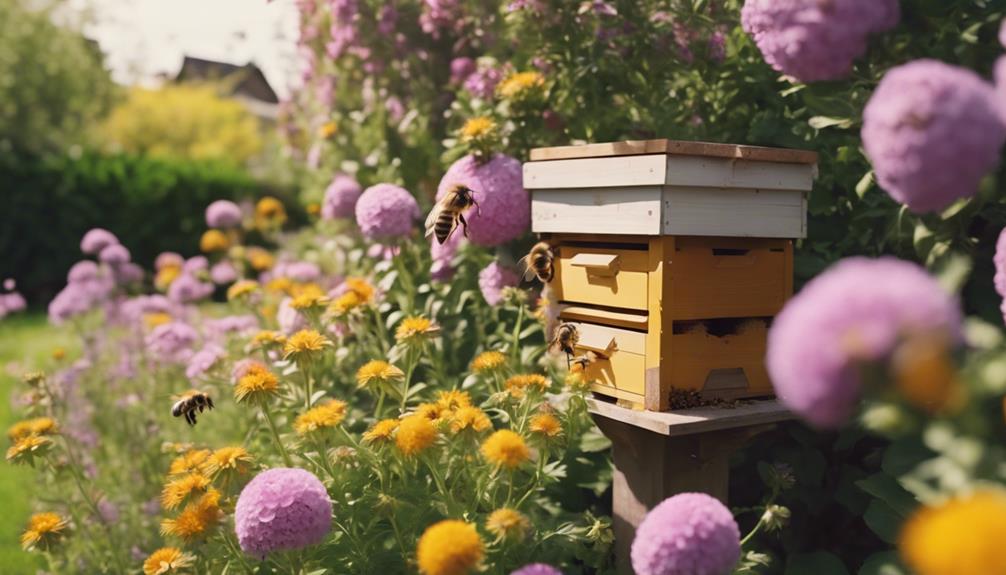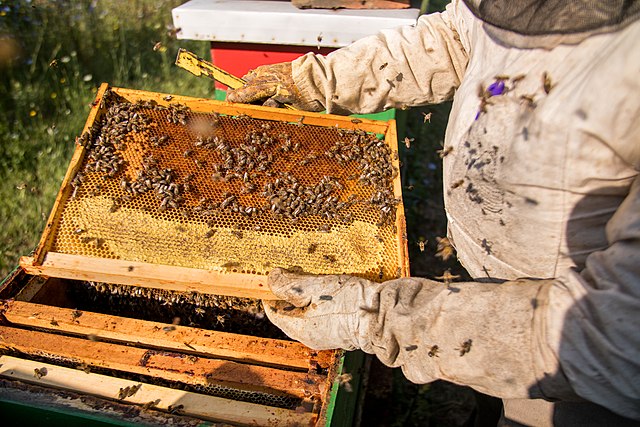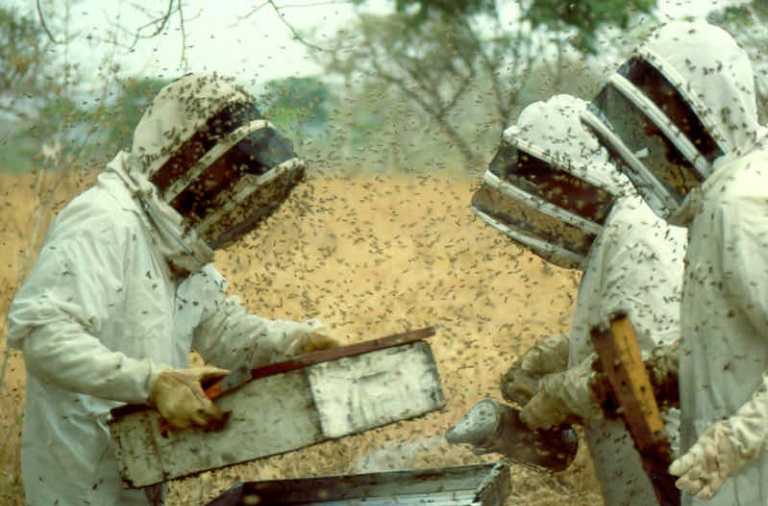
Having just one beehive is totally okay! It's a fantastic choice for beginners. With one hive, you can give all your attention to that single colony and really get to know the bees there. Plus, it's simpler to manage, needing less time and resources. Perfect if you're tight on space. But hey, there's more to learn about the benefits of maintaining a single hive and how it compares to having multiple hives. Stick around to discover how one hive can kickstart your beekeeping journey!
Benefits of Maintaining a Single Hive
Maintaining a single hive can be beneficial for beginner beekeepers as it allows for focused attention and better understanding of bee behavior. With just one hive to manage, you can really get to know your bees on a personal level. By observing their activities closely, you'll start to recognize patterns and behaviors that will help you become a better beekeeper.
Plus, having one hive means you can dedicate more time and effort to ensuring its health and productivity. It's like having a close-knit community to look after. When you focus on one hive, you can spot any issues quickly and address them promptly. This hands-on approach can lead to a stronger bond with your bees and a deeper appreciation for the fascinating world of beekeeping.
Pollination Potential of One Hive
One bee hive can contribute significantly to pollination in your garden or surrounding area. Bees are excellent pollinators, buzzing from flower to flower in search of nectar and inadvertently transferring pollen in the process.
With just one hive, you can see improvements in the yield and quality of fruits, vegetables, and flowers in your garden. These busy little insects work tirelessly to guarantee plants reproduce, leading to a more vibrant and abundant ecosystem.
Hive Management Considerations
So, in terms of hive management considerations for your single bee hive, you'll want to pay attention to factors like hive size Beekeeping tips and bee population.
Ensuring the hive is of sufficient size to accommodate the growing bee population is vital for their well-being and productivity.
Monitoring these aspects will help you maintain a healthy and thriving hive for your buzzing friends.
Hive Size
Considering the ideal hive size is vital for effective hive management. When thinking about hive size, it's important to find a balance. Too small a hive can lead to overcrowding, stress, and swarming.
On the other hand, a hive that's too large might be challenging for the bees to regulate temperature and defend against pests. Aim for a hive size that allows for expansion as the colony grows but isn't overwhelmingly spacious.

Remember, a hive that's just right will help your bees thrive, maintain a healthy brood nest, and efficiently store honey. By monitoring the hive's population and activity levels, you can adjust the size accordingly.
Finding the sweet spot in hive size is key to happy, productive bees.
Bee Population
Finding the ideal balance in bee population within a hive is essential for effective hive management. When considering bee population, keep these key points in mind:
- Worker Bees: The majority of bees in a hive are worker bees, responsible for tasks like foraging, nursing the brood, and maintaining the hive. Queen Bee: The queen bee plays a critical role in laying eggs, ensuring the hive's survival and growth. Drone Bees: Drones are male bees whose primary role is mating with the queen bee. Population Dynamics: Monitoring bee population dynamics helps assess hive health and productivity, guiding management decisions.
Maintaining the right mix of bees is crucial for a thriving hive. Keep a close eye on population levels to support your bees' well-being and maximize honey production.
Impact on Bee Colony Health
Having only one bee hive can potentially impact the health of the bee colony due to limited genetic diversity and resources. In a single hive, bees may interbreed, leading to a reduction in genetic variation, making the colony more vulnerable to diseases and environmental changes.
Additionally, with just one hive, there might be competition for food sources and nesting sites, which can stress the bees and impact their overall well-being. To guarantee a thriving and resilient bee colony, it's advantageous to have multiple hives to promote genetic diversity and provide ample resources for the bees.
Minimizing Competitive Behavior
When you useful beekeeping tips have just one beehive, you can help minimize competitive behavior among your bees.
By maintaining a single hive, you encourage hive harmony and optimize the social structure within it.
This can lead to a more peaceful and productive bee colony overall.
Beehive Harmony
To maintain beehive harmony and minimize competitive behavior among bees, strategic placement of hive entrances and adequate spacing between hives is crucial. Here are some tips to help your bees live together peacefully:
- Provide Different Entrance Colors: Bees are naturally attracted to their hive's color and pattern. By using unique colors for each hive entrance, you can help bees easily identify their home. Plant Diverse Flowers: Having a variety of flowers in your garden provides bees with abundant food sources, reducing competition for nectar and pollen. Avoid Overcrowding: Make sure there's enough space between hives to prevent overcrowding, which can lead to increased aggression among bees. Regular Hive Inspections: By monitoring hive health and population, you can address any issues promptly and maintain a harmonious environment for your bees.
Social Structure Optimization
Promote a balanced social structure among your bee colonies by implementing strategies that minimize competitive behavior within the hive. Bees have a complex hierarchy within the colony, with each bee playing a crucial role in maintaining the hive's functionality.

To maintain harmony, guarantee an adequate food supply, space, and resources for all your bees. Avoid overcrowding by providing additional space when needed. This helps reduce competition for resources, preventing aggressive behavior among the bees.
Ensuring Adequate Honey Production
For optimal honey production with just one bee hive, maintaining a consistent supply of nectar-rich flowers nearby is crucial. You want your bees to have access to a variety of flowers to make sure they can gather enough nectar for honey production. Here are some tips to help you guarantee an adequate honey yield:
- Plant a diverse range of flowers in your garden or surrounding area. Avoid using pesticides that could harm the bees or contaminate the honey. Consider installing a bee-friendly water source nearby for hydration. Regularly monitor your hive to make certain the bees are healthy and active in their honey-making process.
Simplifying Beekeeping for Beginners
Simplify your beekeeping journey as a beginner by focusing on basic hive management techniques and bee behavior understanding.
Start by learning about the different roles bees play in the hive - from the queen to the worker bees. Understanding their behavior will help you anticipate their needs and react accordingly.
Keep your hive healthy by regularly checking for pests, diseases, and ensuring they've a good food supply.
Don't overwhelm yourself with too many hives at once; start with one and gradually expand as you gain more experience.
Conserving Space and Resources
To maximize efficiency in beekeeping, consider the conservation of space and resources as a key priority.
- Utilize Vertical Space: Opt for vertical hives or stackable boxes to make the most of limited space. Implement Sustainable Practices: Use recycled materials for hive components and consider planting bee-friendly flora to reduce resource consumption. Practice Strategic Hive Placement: Position your hive in a spot with the best sunlight and protection from harsh elements. Regularly Assess and Streamline: Periodically review your beekeeping setup to eliminate any unnecessary clutter and make sure every resource is utilized effectively.
One Hive Vs. Multiple Hive Comparison
Consider the advantages and challenges of managing a single bee hive versus multiple hives to determine the most suitable approach for your beekeeping endeavors.
Having just one hive can be a great starting point if you're new to beekeeping or have limited space. It allows you to focus your attention and resources on a single colony, making management more straightforward.
However, with multiple hives, you can increase honey production, improve genetic diversity, and have a backup in case of issues like disease or queen problems. It also provides a learning opportunity to compare hive behaviors and performance.
Just remember, more hives mean more time and effort required. Whether you choose one hive or several, the key is to make sure you can provide proper care and attention to your bees.
Frequently Asked Questions
Can Having Just One Hive Lead to Loneliness for the Bees?
Having just one hive can make bees feel like a lone tree in a vast field. They thrive in community. Consider adding more hives to create a bustling hive city, fostering a vibrant and connected bee population.
Will a Single Hive Be Sufficient for Pollinating a Large Garden?
For pollinating a large garden, one hive might not be sufficient. Consider adding more hives to guarantee thorough pollination. Bees are hard workers, but having multiple hives can boost pollination efficiency.
How Does Hive Location Affect the Success of Maintaining One Hive?
When choosing where to place your hive, remember success hinges on location. Opt for a spot with ample sunlight, protection from harsh winds, and easy access for maintenance. By following these tips, you guarantee hive health.
What Are the Risks of Disease Spread in a Solitary Hive Setup?
When keeping just one hive, the risks of disease spread increase due to limited genetic diversity and fewer bees to combat illnesses. Regular monitoring and preventative measures are essential to protect your solitary hive.
Do Bees in a Single Hive Have a Higher Risk of Swarming?
When you have just one hive, bees may swarm if the colony grows too large for the space. Regular hive inspections and proper management can help prevent swarming and maintain a healthy bee population.